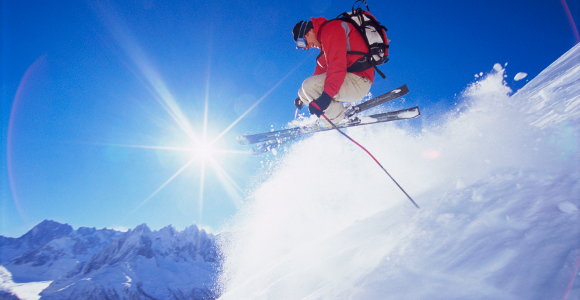Downhill skiing is something that most of us do only during the winter season. That begs the question of how to transition into skiing season with muscles that can handle the big demands of this sport. Here are some of the common tips that trainers and fitness experts give their clients and the general public for getting back into downhill skiing with the best chance of quick adaptation to the slopes.
Training Motion Over MusclesA lot of trainers suggest overall training activities rather than isolating specific muscles for downhill skiing. Because so many different muscle groups are used, it's much more efficient to focus on the kinds of actions that downhill skiers need to do.
- Cardio Training Machines - One of the basic aspects of training for downhill skiing is to challenge your cardio and lung capacity. Gym machines, like the treadmill, elliptical machine, rower or exercise bike, can all help with this crucial goal.
- Balance Balls and Other Balance Challenges - Another aspect that some people forget about in preparing for downhill skiing is balance. The body uses a lot of its natural balancing abilities on the slopes to keep the skis pointed the right way and to prevent falling. Exercising on a balance ball can be a good way to train for hitting the slopes.
- Downhill Hiking - Downhill hiking or similar activities can simulate some of the muscle challenges involved in holding the legs steady for downhill skiing. Some types of gym machines can provide a downhill setting for challenging the hamstrings and other leg muscles. Individuals can also use agility drills in the gym to get ready for the specific kinds of leg motions that are part of dexterity on the mountainside.
- Plyometric Activities - Another specific type of gym exercise that prepares skiers is called plyometrics. It's the practice of "explosive" muscle activities that will build up strength for quick responses to external challenges. A wide range of plyometric activities can be found in any comprehensive fitness manual or similar resource. These are great to practice in the gym before heading to the ski resort.
- Specific Skiing Machines - Some gyms provide specific machines that simulate the kinds of motions involved in downhill skiing. These machines often have set positions for the lower body, as well as some weight or resistance challenges for the upper body. The idea is to simulate the kinds of actions that skiers do with ski poles. When these machines are available, they are a great option for ski preparation.
Anyone who wants to train for a winter skiing season can look at the above choices as some of the basic ways to prepare their bodies. Downhill skiing is a demanding activity in many ways, with the potential for many kinds of injury. Making sure muscles are up to the challenges involved is one way to help lower the risk of severe injury on the slopes.



